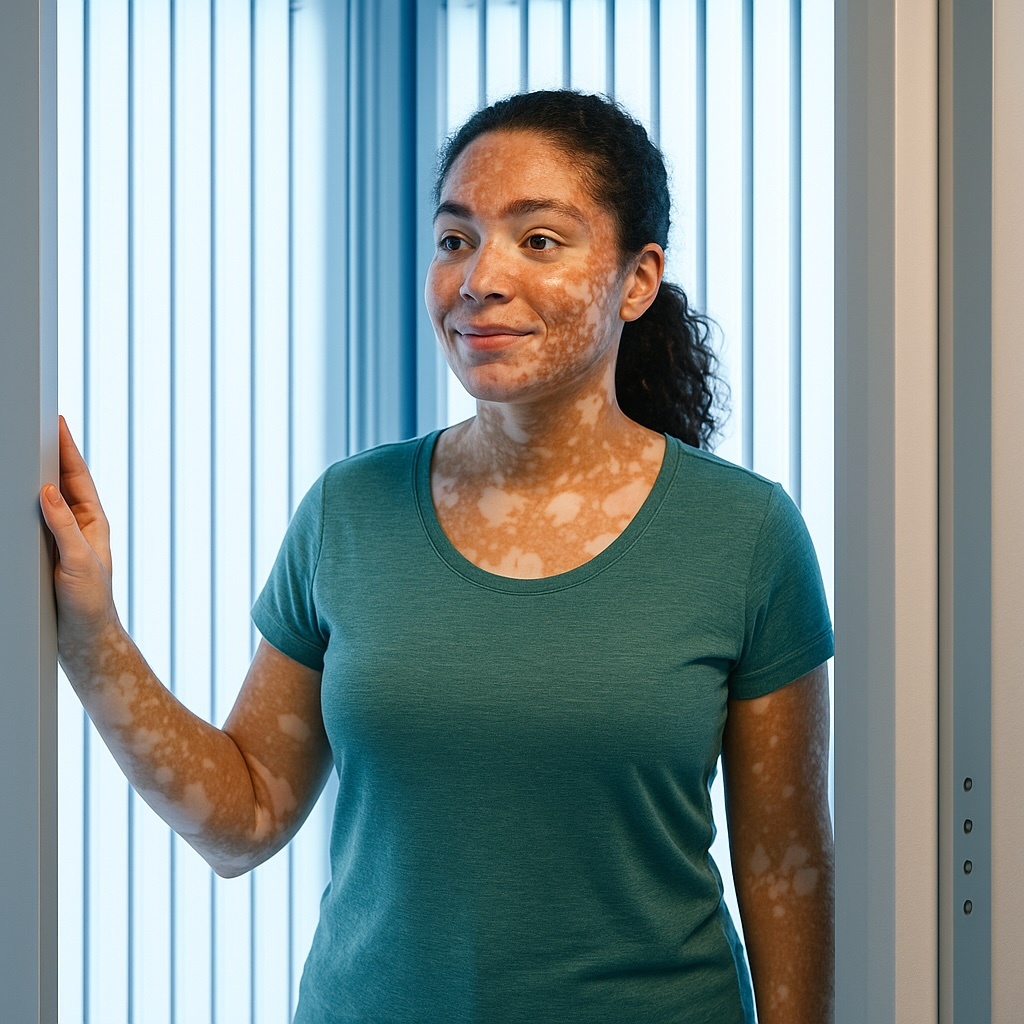New
Phototherapy: How Long Does the Color Stay?
Anyone who’s done phototherapy has likely asked the obvious question: will the color last after I stop?
TL;DR: Phototherapy works — but it’s a marathon, not a sprint. It usually takes 9–12 months of steady treatment (2–3 times a week, in a clinic or at home) before you see real results.
The good news: once repigmentation happens, it can stick. Most people relapse within 2–5 years, but if you go longer with treatment and add simple maintenance (like tacrolimus ointment), your results are much more likely to last.
How long do results usually last?
Even in the best of worlds, vitiligo is a chronic, relapsing condition. Large follow-up studies and reviews consistently show that relapse is common after treatment stops:
- Across phototherapy and topical regimens, about 40–50% of patients start to lose acquired color within 2 years after successful repigmentation.
- Longer horizons show even more: up to 50–75% relapse within 3–5 years, especially if no maintenance therapy is used.
- Relapse rates vary by site: the face and trunk are most stable, while hands, feet, and bony prominences relapse faster.
- Children often relapse less, possibly due to higher regenerative capacity, but still need long-term monitoring.
- Even after excimer laser or topical steroids, durability without maintenance is modest—studies report relapse in roughly half of cases within 1–3 years.
So, while the Sheba study data are unusually encouraging – with nearly 60% holding repigmentation beyond 6 years – the more typical clinical reality is that vitiligo tends to come back sooner without some form of ongoing care.
What the study did
The team reviewed records of 176 people treated with ≥20 NB-UVB sessions between 2003 and 2022. Clinically meaningful response meant ≥50% repigmentation, with durability defined as holding that gain for at least 6 months after stopping. Follow-up extended up to 19 years.
The headline numbers:
- 45% of patients reached at least 50% repigmentation by the end of NB-UVB, with the face/neck doing best.
- Among those responders, 95% kept the gains for at least 6 months; and strikingly, 59% were still holding color more than 6 years later.
- Longer treatment courses (>18 months) and higher cumulative dose (>356 J/cm²) were tied to better durability.
- Age, sex, and skin phototype didn’t change durability odds.
Yes, six years. That’s not a typo. For a subset of good responders, repigmentation stuck around for the long haul.
Why this matters
Patients often quit phototherapy too soon because weekly clinic visits are a grind and “it’ll just fade anyway,” right? This study suggests that if you push to a solid response (≥50%), you’ve got a real shot at long-term stability—especially on the face and neck.
It also supports a practical rule: give NB-UVB enough time. Many people don’t show their best response until around a year, and three to six months is often too short to call it quits.
Safety check
NB-UVB has a good safety record in vitiligo. In this cohort, no skin cancers were reported during follow-up. NB-UVB is not linked to higher skin cancer risk; rates appear similar to the general population, though very high session counts can increase actinic keratoses.
How does this compare with other evidence on “staying power”?
Phototherapy as a class
A 2017 meta-analysis reaffirmed NB-UVB as the first-line phototherapy, especially for the face/neck, and flagged that you typically need around a year for maximal results. That lines up neatly with the Sheba protocol and outcomes.
- NB-UVB durability in older studies
Smaller cohorts have shown mixed durability: some maintained color for 2 years, others relapsed sooner. Variability likely reflects different protocols (dose escalation, frequency) and patient mix. The Sheba team’s more “push the dose if tolerated” approach may explain their stronger long-term retention.
- PUVA (psoralen + UVA)
PUVA works, but practical downsides (photosensitizer, side effects) limit long-term use. Historical series suggested most responders eventually relapsed after stopping PUVA, which — combined with safety/logistics — helped NB-UVB replace it as the standard.
- Excimer Light (308 nm)
Excimer can be fast and focal — great for small facial patches — but durability data are limited. Reviews suggest outcomes comparable to NB-UVB for localized disease, but maintenance plans are less defined outside combination regimens.
- Topical JAK inhibitors (ruxolitinib cream)
They work — and they’ve changed the conversation — but vitiligo is chronic. Early follow-ups hint that some patients keep facial repigmentation for a few months after stopping, while others benefit from ongoing or maintenance-style use; robust long-term durability data are still maturing. Translation: expect to maintain results rather than “cure and forget.”
Can we do anything to make results last?
- Aim for a strong finish
This study’s clearest signal: ≥50% repigmentation creates multi-year results. So stick with a well-run NB-UVB program long enough to hit meaningful milestones.
- Mind the dose and duration
Within safety limits, longer courses and higher cumulative dose correlated with better staying power—something to discuss with your dermatologist when mapping a plan.
- Consider maintenance on the back end
After you stop the lights, twice-weekly tacrolimus 0.1% ointment has randomized-trial evidence for preventing relapse in previously repigmented areas. It’s simple, at-home, and can buy you stability.
- Be realistic with new topicals
For ruxolitinib cream, early extension and narrative reviews suggest some repigmentation persists off-therapy, but many patients need continued or intermittent use to prevent slide-back. Think “maintenance,” not one-and-done.
- Choose your battles (anatomy matters)
Face and neck are most cooperative; hands and feet remain stubborn across all modalities. If you’re budgeting time and energy, this hierarchy still holds.
For patients:
Think of NB-UVB less as a short-term fix and more as a long-term investment. If you respond well, much of that color can stay for years—especially on the face. Adding simple maintenance (like tacrolimus ointment) improves the odds.
For clinicians:
- Set expectations: most require 9–12 months to see full effect; 3–6 is too early.
- Treat to ≥50% repigmentation, and discuss maintenance afterward.
- Reassure on safety: NB-UVB shows no elevated long-term skin cancer risk in vitiligo.
Bottom line
Treat vitiligo less like a sprint and more like a well-paced marathon: push long enough to build lasting color, then maintain smartly.

Yan Valle
Professor h.c., CEO VR Foundation | Author A No-Nonsense Guide To Vitiligo
Read more:
- Vitiligo Patient Journey Map
- FAQ: What's better: laser or phototherapy?
- The Real Price Tag of Treating Vitiligo (2025 Edition)
- Rethinking Vitiligo – Five Distinct Faces of a Complex Disease

FAQOther Questions
- Does vitiligo increase the risk of skin cancer?
No, it does not. Despite common misconceptions, people with vitiligo are actually at a lower risk of developing skin cancer—including both nonmelanoma skin cancer (NMSC) and mal...
- How can I explain vitiligo to my children?
Vitiligo can be confusing for children because it doesn’t resemble an "illness" in the typical sense. Choosing the right way to explain it depends on your child’s age and maturi...
- Is it possible to stop the progression of vitiligo?
While it's not always possible to quickly stop vitiligo progression, there are some treatments that can help slow or halt the spread of the condition in many cases: Corticoster...
Though it is not always easy to treat vitiligo, there is much to be gained by clearly understanding the diagnosis, the future implications, treatment options and their outcomes.
Many people deal with vitiligo while remaining in the public eye, maintaining a positive outlook, and having a successful career.
Copyright (C) Bodolóczki JúliaBy taking a little time to fill in the anonymous questionnaire, you can help researchers better understand and fight vitiligo.
